Tao Zheng
Multi-Agent Intelligence for Multidisciplinary Decision-Making in Gastrointestinal Oncology
Dec 23, 2025Abstract:Multimodal clinical reasoning in the field of gastrointestinal (GI) oncology necessitates the integrated interpretation of endoscopic imagery, radiological data, and biochemical markers. Despite the evident potential exhibited by Multimodal Large Language Models (MLLMs), they frequently encounter challenges such as context dilution and hallucination when confronted with intricate, heterogeneous medical histories. In order to address these limitations, a hierarchical Multi-Agent Framework is proposed, which emulates the collaborative workflow of a human Multidisciplinary Team (MDT). The system attained a composite expert evaluation score of 4.60/5.00, thereby demonstrating a substantial improvement over the monolithic baseline. It is noteworthy that the agent-based architecture yielded the most substantial enhancements in reasoning logic and medical accuracy. The findings indicate that mimetic, agent-based collaboration provides a scalable, interpretable, and clinically robust paradigm for automated decision support in oncology.
Learning Accurate, Efficient, and Interpretable MLPs on Multiplex Graphs via Node-wise Multi-View Ensemble Distillation
Feb 09, 2025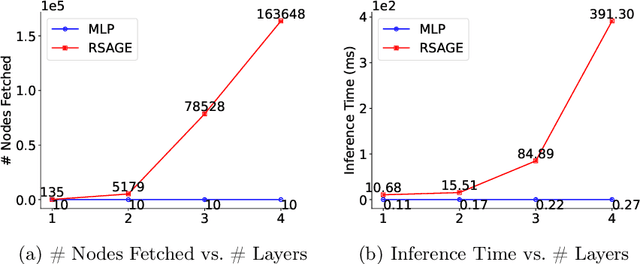
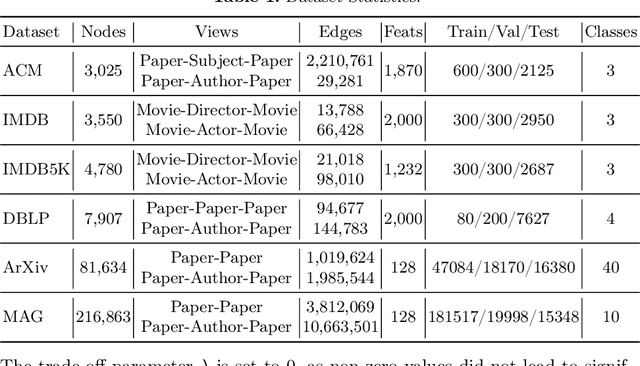


Abstract:Multiplex graphs, with multiple edge types (graph views) among common nodes, provide richer structural semantics and better modeling capabilities. Multiplex Graph Neural Networks (MGNNs), typically comprising view-specific GNNs and a multi-view integration layer, have achieved advanced performance in various downstream tasks. However, their reliance on neighborhood aggregation poses challenges for deployment in latency-sensitive applications. Motivated by recent GNN-to-MLP knowledge distillation frameworks, we propose Multiplex Graph-Free Neural Networks (MGFNN and MGFNN+) to combine MGNNs' superior performance and MLPs' efficient inference via knowledge distillation. MGFNN directly trains student MLPs with node features as input and soft labels from teacher MGNNs as targets. MGFNN+ further employs a low-rank approximation-based reparameterization to learn node-wise coefficients, enabling adaptive knowledge ensemble from each view-specific GNN. This node-wise multi-view ensemble distillation strategy allows student MLPs to learn more informative multiplex semantic knowledge for different nodes. Experiments show that MGFNNs achieve average accuracy improvements of about 10% over vanilla MLPs and perform comparably or even better to teacher MGNNs (accurate); MGFNNs achieve a 35.40$\times$-89.14$\times$ speedup in inference over MGNNs (efficient); MGFNN+ adaptively assigns different coefficients for multi-view ensemble distillation regarding different nodes (interpretable).
Continuous Concepts Removal in Text-to-image Diffusion Models
Nov 30, 2024

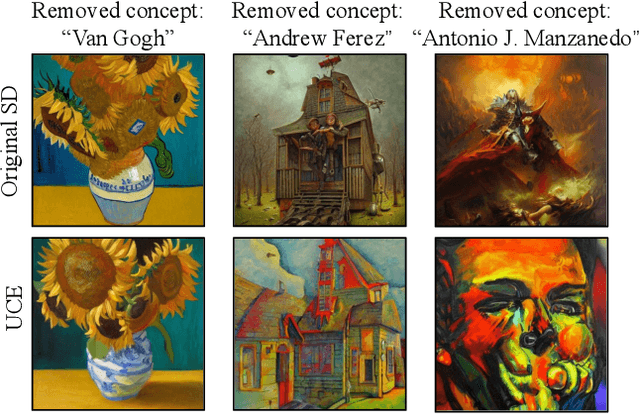

Abstract:Text-to-image diffusion models have shown an impressive ability to generate high-quality images from input textual descriptions. However, concerns have been raised about the potential for these models to create content that infringes on copyrights or depicts disturbing subject matter. Removing specific concepts from these models is a promising potential solution to this problem. However, existing methods for concept removal do not work well in practical but challenging scenarios where concepts need to be continuously removed. Specifically, these methods lead to poor alignment between the text prompts and the generated image after the continuous removal process. To address this issue, we propose a novel approach called CCRT that includes a designed knowledge distillation paradigm. It constrains the text-image alignment behavior during the continuous concept removal process by using a set of text prompts generated through our genetic algorithm, which employs a designed fuzzing strategy. We conduct extensive experiments involving the removal of various concepts. The results evaluated through both algorithmic metrics and human studies demonstrate that our CCRT can effectively remove the targeted concepts in a continuous manner while maintaining the high generation quality (e.g., text-image alignment) of the model.
Negative-Free Self-Supervised Gaussian Embedding of Graphs
Nov 02, 2024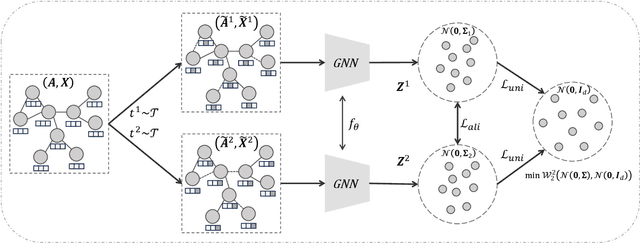
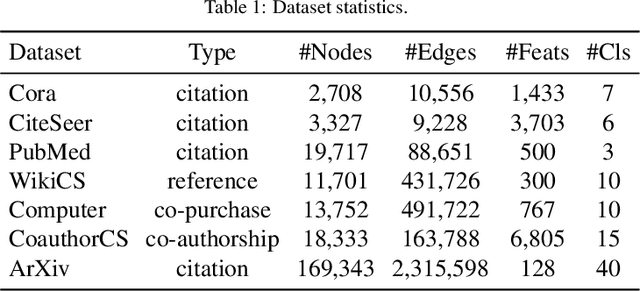
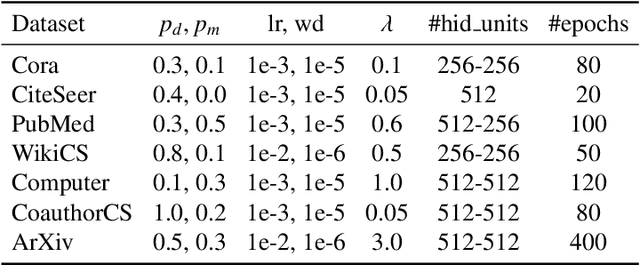

Abstract:Graph Contrastive Learning (GCL) has recently emerged as a promising graph self-supervised learning framework for learning discriminative node representations without labels. The widely adopted objective function of GCL benefits from two key properties: \emph{alignment} and \emph{uniformity}, which align representations of positive node pairs while uniformly distributing all representations on the hypersphere. The uniformity property plays a critical role in preventing representation collapse and is achieved by pushing apart augmented views of different nodes (negative pairs). As such, existing GCL methods inherently rely on increasing the quantity and quality of negative samples, resulting in heavy computational demands, memory overhead, and potential class collision issues. In this study, we propose a negative-free objective to achieve uniformity, inspired by the fact that points distributed according to a normalized isotropic Gaussian are uniformly spread across the unit hypersphere. Therefore, we can minimize the distance between the distribution of learned representations and the isotropic Gaussian distribution to promote the uniformity of node representations. Our method also distinguishes itself from other approaches by eliminating the need for a parameterized mutual information estimator, an additional projector, asymmetric structures, and, crucially, negative samples. Extensive experiments over seven graph benchmarks demonstrate that our proposal achieves competitive performance with fewer parameters, shorter training times, and lower memory consumption compared to existing GCL methods.
Heterogeneous Space Fusion and Dual-Dimension Attention: A New Paradigm for Speech Enhancement
Aug 13, 2024Abstract:Self-supervised learning has demonstrated impressive performance in speech tasks, yet there remains ample opportunity for advancement in the realm of speech enhancement research. In addressing speech tasks, confining the attention mechanism solely to the temporal dimension poses limitations in effectively focusing on critical speech features. Considering the aforementioned issues, our study introduces a novel speech enhancement framework, HFSDA, which skillfully integrates heterogeneous spatial features and incorporates a dual-dimension attention mechanism to significantly enhance speech clarity and quality in noisy environments. By leveraging self-supervised learning embeddings in tandem with Short-Time Fourier Transform (STFT) spectrogram features, our model excels at capturing both high-level semantic information and detailed spectral data, enabling a more thorough analysis and refinement of speech signals. Furthermore, we employ the innovative Omni-dimensional Dynamic Convolution (ODConv) technology within the spectrogram input branch, enabling enhanced extraction and integration of crucial information across multiple dimensions. Additionally, we refine the Conformer model by enhancing its feature extraction capabilities not only in the temporal dimension but also across the spectral domain. Extensive experiments on the VCTK-DEMAND dataset show that HFSDA is comparable to existing state-of-the-art models, confirming the validity of our approach.
Scalable and Adaptive Spectral Embedding for Attributed Graph Clustering
Aug 11, 2024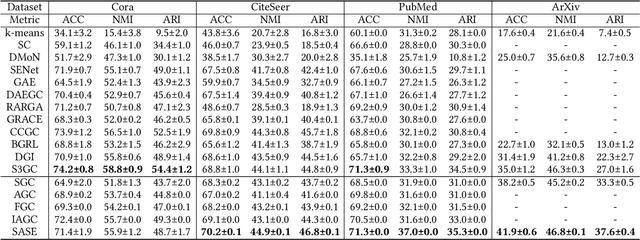


Abstract:Attributed graph clustering, which aims to group the nodes of an attributed graph into disjoint clusters, has made promising advancements in recent years. However, most existing methods face challenges when applied to large graphs due to the expensive computational cost and high memory usage. In this paper, we introduce Scalable and Adaptive Spectral Embedding (SASE), a simple attributed graph clustering method devoid of parameter learning. SASE comprises three main components: node features smoothing via $k$-order simple graph convolution, scalable spectral clustering using random Fourier features, and adaptive order selection. With these designs, SASE not only effectively captures global cluster structures but also exhibits linear time and space complexity relative to the graph size. Empirical results demonstrate the superiority of SASE. For example, on the ArXiv dataset with 169K nodes and 1.17M edges, SASE achieves a 6.9\% improvement in ACC and a $5.87\times$ speedup compared to the runner-up, S3GC.
Bootstrap Latents of Nodes and Neighbors for Graph Self-Supervised Learning
Aug 09, 2024Abstract:Contrastive learning is a significant paradigm in graph self-supervised learning. However, it requires negative samples to prevent model collapse and learn discriminative representations. These negative samples inevitably lead to heavy computation, memory overhead and class collision, compromising the representation learning. Recent studies present that methods obviating negative samples can attain competitive performance and scalability enhancements, exemplified by bootstrapped graph latents (BGRL). However, BGRL neglects the inherent graph homophily, which provides valuable insights into underlying positive pairs. Our motivation arises from the observation that subtly introducing a few ground-truth positive pairs significantly improves BGRL. Although we can't obtain ground-truth positive pairs without labels under the self-supervised setting, edges in the graph can reflect noisy positive pairs, i.e., neighboring nodes often share the same label. Therefore, we propose to expand the positive pair set with node-neighbor pairs. Subsequently, we introduce a cross-attention module to predict the supportiveness score of a neighbor with respect to the anchor node. This score quantifies the positive support from each neighboring node, and is encoded into the training objective. Consequently, our method mitigates class collision from negative and noisy positive samples, concurrently enhancing intra-class compactness. Extensive experiments are conducted on five benchmark datasets and three downstream task node classification, node clustering, and node similarity search. The results demonstrate that our method generates node representations with enhanced intra-class compactness and achieves state-of-the-art performance.
Reliable Node Similarity Matrix Guided Contrastive Graph Clustering
Aug 07, 2024
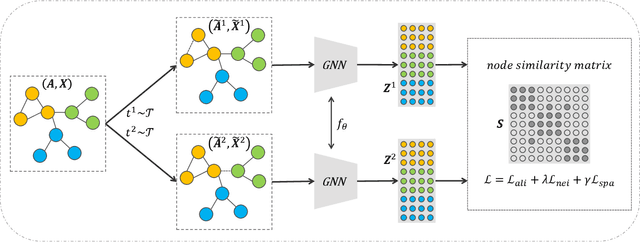
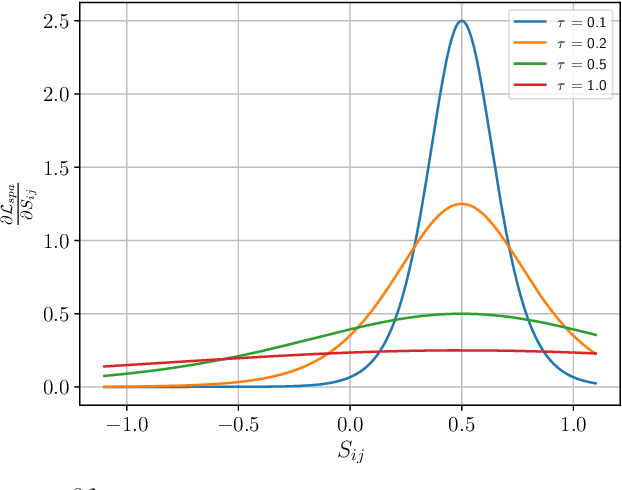
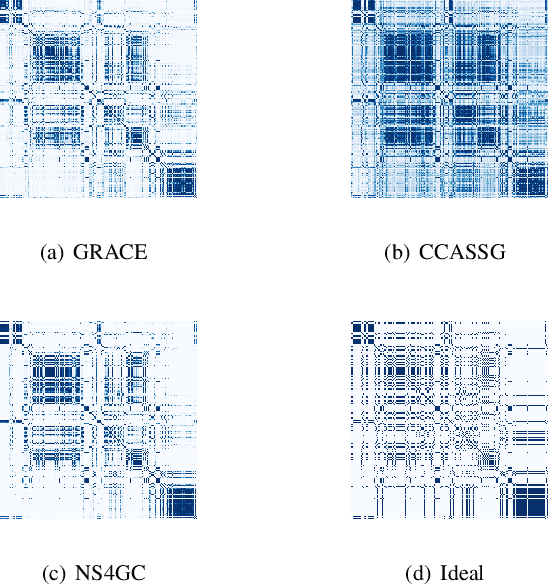
Abstract:Graph clustering, which involves the partitioning of nodes within a graph into disjoint clusters, holds significant importance for numerous subsequent applications. Recently, contrastive learning, known for utilizing supervisory information, has demonstrated encouraging results in deep graph clustering. This methodology facilitates the learning of favorable node representations for clustering by attracting positively correlated node pairs and distancing negatively correlated pairs within the representation space. Nevertheless, a significant limitation of existing methods is their inadequacy in thoroughly exploring node-wise similarity. For instance, some hypothesize that the node similarity matrix within the representation space is identical, ignoring the inherent semantic relationships among nodes. Given the fundamental role of instance similarity in clustering, our research investigates contrastive graph clustering from the perspective of the node similarity matrix. We argue that an ideal node similarity matrix within the representation space should accurately reflect the inherent semantic relationships among nodes, ensuring the preservation of semantic similarities in the learned representations. In response to this, we introduce a new framework, Reliable Node Similarity Matrix Guided Contrastive Graph Clustering (NS4GC), which estimates an approximately ideal node similarity matrix within the representation space to guide representation learning. Our method introduces node-neighbor alignment and semantic-aware sparsification, ensuring the node similarity matrix is both accurate and efficiently sparse. Comprehensive experiments conducted on $8$ real-world datasets affirm the efficacy of learning the node similarity matrix and the superior performance of NS4GC.
 Add to Chrome
Add to Chrome Add to Firefox
Add to Firefox Add to Edge
Add to Edge